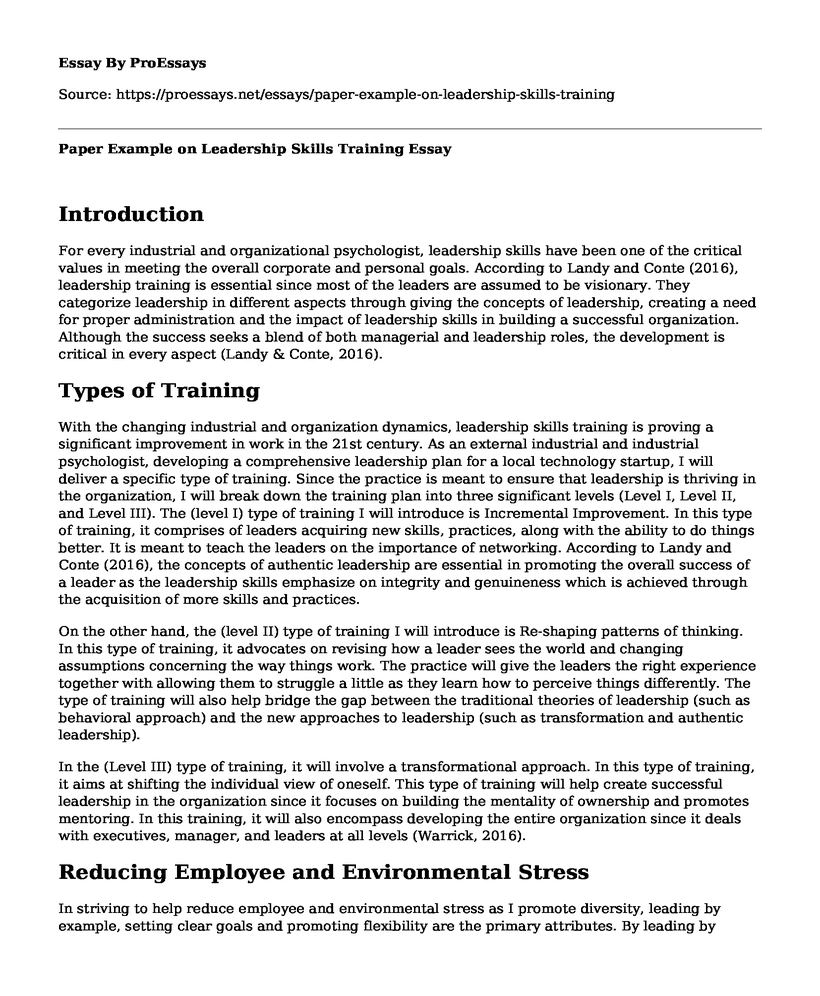Introduction
For every industrial and organizational psychologist, leadership skills have been one of the critical values in meeting the overall corporate and personal goals. According to Landy and Conte (2016), leadership training is essential since most of the leaders are assumed to be visionary. They categorize leadership in different aspects through giving the concepts of leadership, creating a need for proper administration and the impact of leadership skills in building a successful organization. Although the success seeks a blend of both managerial and leadership roles, the development is critical in every aspect (Landy & Conte, 2016).
Types of Training
With the changing industrial and organization dynamics, leadership skills training is proving a significant improvement in work in the 21st century. As an external industrial and industrial psychologist, developing a comprehensive leadership plan for a local technology startup, I will deliver a specific type of training. Since the practice is meant to ensure that leadership is thriving in the organization, I will break down the training plan into three significant levels (Level I, Level II, and Level III). The (level I) type of training I will introduce is Incremental Improvement. In this type of training, it comprises of leaders acquiring new skills, practices, along with the ability to do things better. It is meant to teach the leaders on the importance of networking. According to Landy and Conte (2016), the concepts of authentic leadership are essential in promoting the overall success of a leader as the leadership skills emphasize on integrity and genuineness which is achieved through the acquisition of more skills and practices.
On the other hand, the (level II) type of training I will introduce is Re-shaping patterns of thinking. In this type of training, it advocates on revising how a leader sees the world and changing assumptions concerning the way things work. The practice will give the leaders the right experience together with allowing them to struggle a little as they learn how to perceive things differently. The type of training will also help bridge the gap between the traditional theories of leadership (such as behavioral approach) and the new approaches to leadership (such as transformation and authentic leadership).
In the (Level III) type of training, it will involve a transformational approach. In this type of training, it aims at shifting the individual view of oneself. This type of training will help create successful leadership in the organization since it focuses on building the mentality of ownership and promotes mentoring. In this training, it will also encompass developing the entire organization since it deals with executives, manager, and leaders at all levels (Warrick, 2016).
Reducing Employee and Environmental Stress
In striving to help reduce employee and environmental stress as I promote diversity, leading by example, setting clear goals and promoting flexibility are the primary attributes. By leading by example, it gives the employee the personal drive and motivation which helps them feel appreciated. As a result, the activity will promote the reduction of stress among employees and they work together. Additionally, setting clear goals for individual employees and group operations will help reduce stress. For the individual goals, they are meant to reduce the environmental and personal stress together with promoting diversity within the organization (DuBrin, 2015).
Conclusion
To sum everything up, flexibility is another critical attribute that helps employees work comfortably in interaction to their working environments. Thus, promoting diversity will significantly help ensure both the success of each and the organization as a whole. In most of the cases, leadership skills deliver a significant impact to the productivity of employees and the general promotion of diversity along with the reduction of environmental stress.
References
DuBrin, A. J. (2015). Leadership: Research findings, practice, and skills. Nelson Education.
Landy, F. J., & Conte, J. M. (2016). Work in the 21st century, Binder ready version: An introduction to Industrial and Organizational Psychology. John Wiley & Sons.
Warrick, D. D. (2016). Positive Transformational Leadership: Building Positive Organizations. Leading the Positive Organization: Actions, Tools, and Processes, 118.
Cite this page
Paper Example on Leadership Skills Training. (2022, Jul 25). Retrieved from https://proessays.net/essays/paper-example-on-leadership-skills-training
If you are the original author of this essay and no longer wish to have it published on the ProEssays website, please click below to request its removal:
- Google Leadership
- The Importance of Leadership in Effective Business Management of Walmart
- Economic Feasibility Analysis Essay
- Paper Example on Team Building, Organizational Behavior and Leadership
- Cisco Systems: Maximizing Stakeholder Engagement for Business Change - Essay Sample
- Essay on Maximizing Benefits with Limited Resources: Rationality in Consumer Decision Making
- Essay on Satyam Scandal: Ramalinga Raju's Fraudulent Misrepresentation of Company Funds







